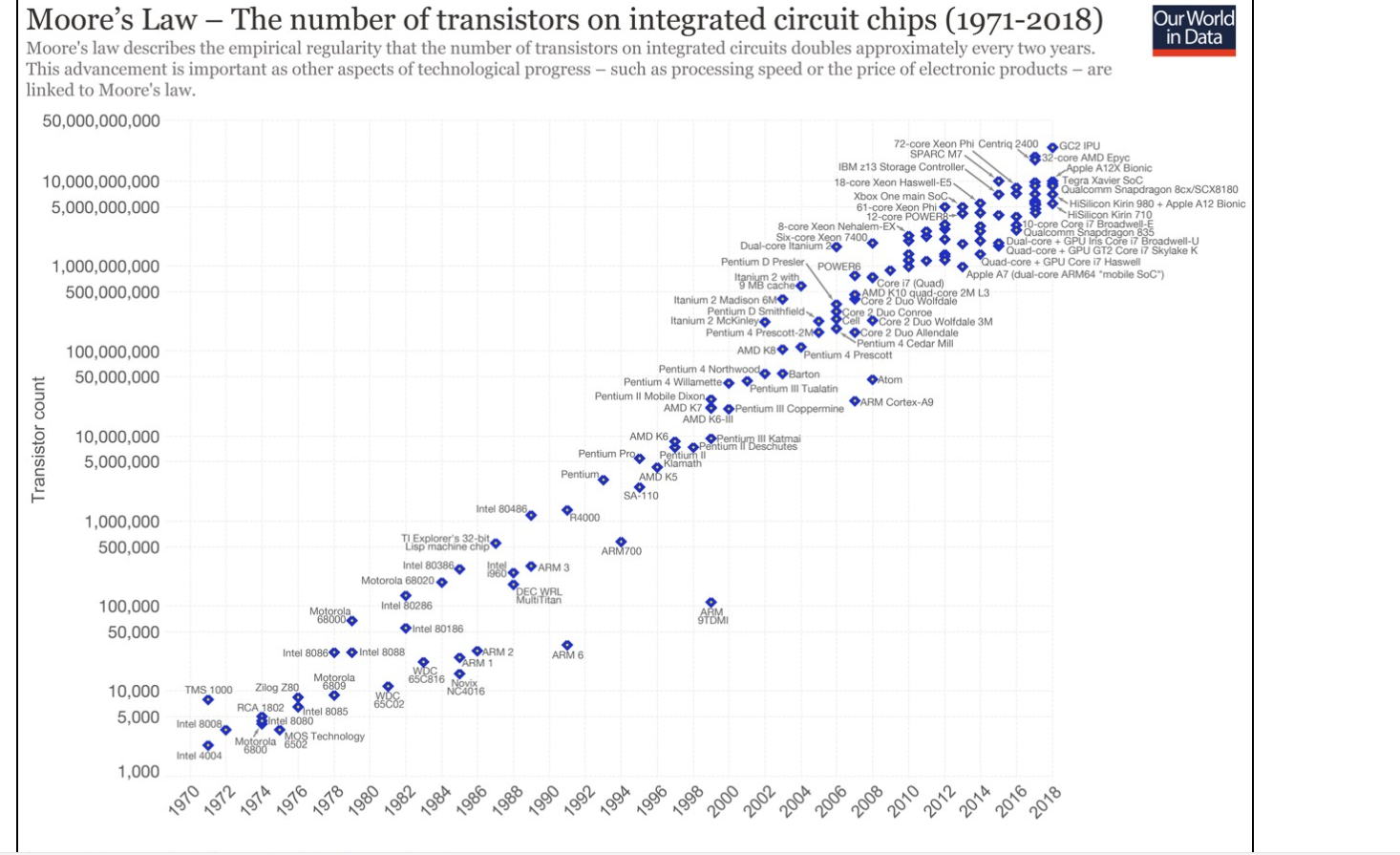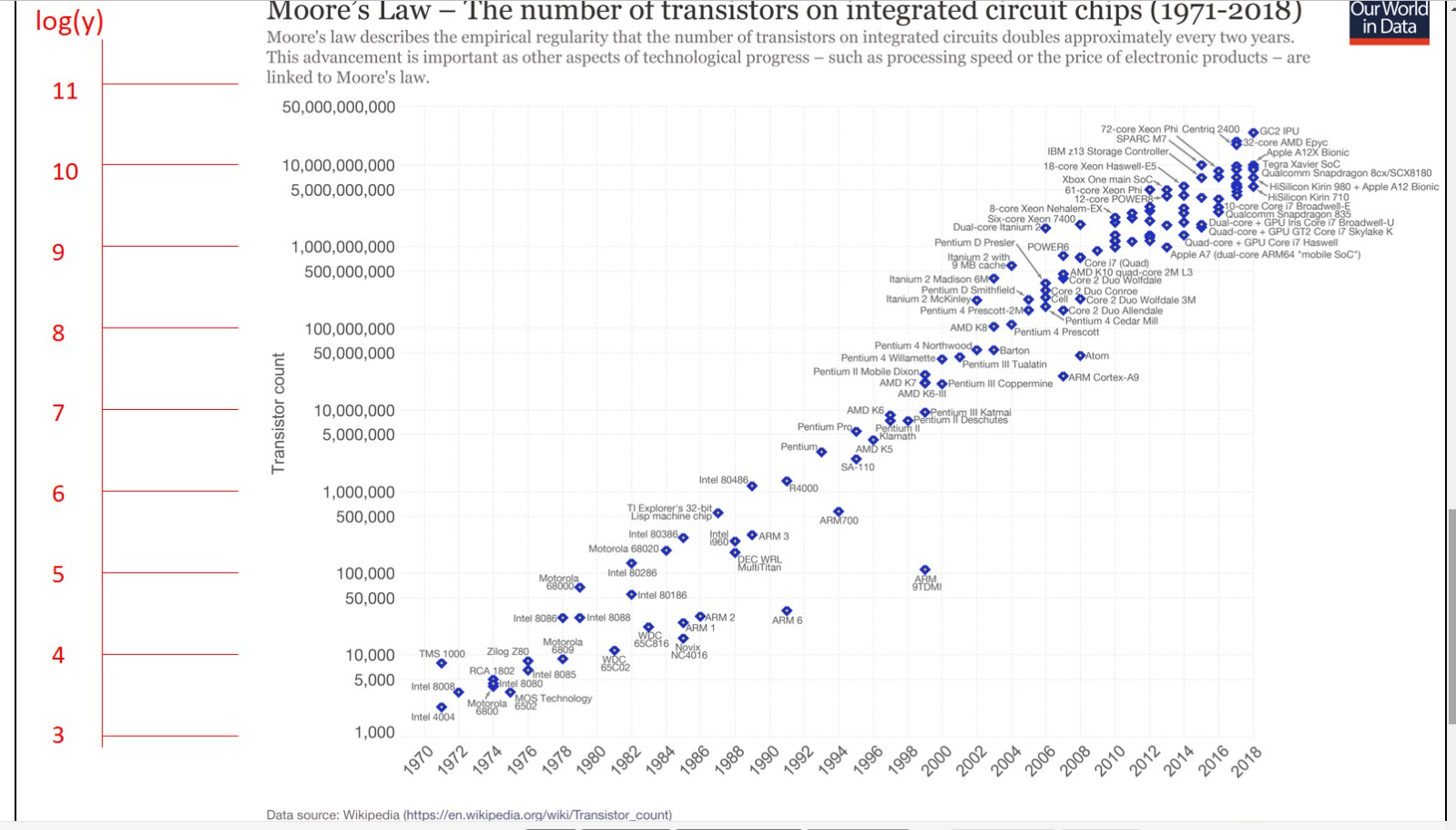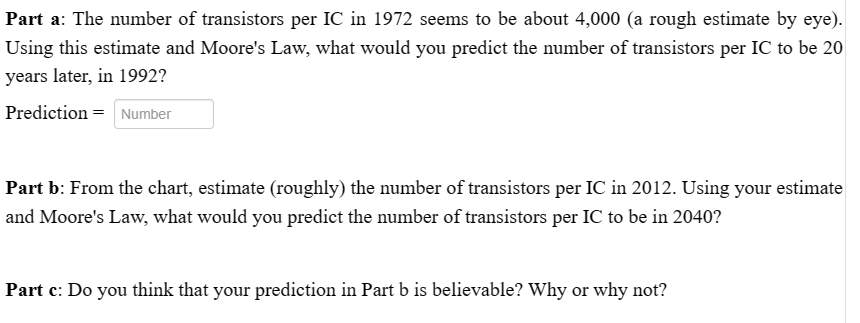Answered step by step
Verified Expert Solution
Question
1 Approved Answer
Solve the problem below. Copy the description of your forecast in the box below and include that as part of your initial Discussion post





Solve the problem below. Copy the description of your forecast in the box below and include that as part of your initial Discussion post in Brightspace. Using "copy" from here in Mobius and "paste" into Brightspace should work. Hint: The chart is taken from https://ourworldindata.org/technological-progress. From the chart, estimate (roughly) the number of transistors per IC in 2012. Using your estimate and Moore's Law, what would you predict the number of transistors per IC to be in 2040? In some applications, the variable being studied increases so quickly ("exponentially") that a regular graph isn't informative. There, a regular graph would show data close to 0 and then a sudden spike at the very end. Instead, for these applications, we often use logarithmic scales. We replace the y-axis tick marks of 1, 2, 3, 4, etc. with y-axis tick marks of 10 = 10, 10 = 100, 10 = 1000, 104 = 10000, etc. In other words, the logarithms of the new tick marks are equally spaced. Technology is one area where progress is extraordinarily rapid. Moore's Law states that the progress of technology (measured in different ways) doubles every 2 years. A common example counts the number of transitors per integrated circuit. A regular y-axis scale is appropriate when a trend is linear, i.e. 100 transistors, 200 transistors, 300 transistors, 400 transistors, etc. However, technology actually increased at a much quicker pace such as 100 transistors,. 1,000 transistors, 10,000 transistors, 100,000 transistors, etc. The following is a plot of the number of transistors per integrated circuit over the period 1971 - 2008 taken from https://ourworldindata.org/technological-progress (that site contains a lot of data, not just for technology). At first, this graph seems to show a steady progression until you look carefully at the y-axis ... it's not linear. From the graph, it seems that from 1971 to 1981 the number of transistors went from about 1,000 to 40,000. Moore's Law predicts that in 10 years, it would double 5 times, i.e. go from 1,000 to 32,000, and the actual values (using very rough estimates) seem to support this. Moore's Law - The number of transistors on integrated circuit chips (1971-2018) Moore's law describes the empirical regularity that the number of transistors on integrated circuits doubles approximately every two years. This advancement is important as other aspects of technological progress - such as processing speed or the price of electronic products - are linked to Moore's law. 50,000,000,000 10,000,000,000 5,000,000,000 Transistor count 1,000,000,000 500,000,000 100,000,000 50,000,000 10,000,000 5,000,000 1,000,000 500,000 100,000 50,000 10,000 5,000 1,000 TMS 1000 Intel 8008 Intel 4004 1970 1972 Motorola 680000 1974 Intel 8086 Intel 8088 Zilog Z80 RCA 1802 Intel 8085 Intel 8080 Motorola MOS Technology 6502 6800 1976 Motorola 6809 TI Explorer's 32-bit Lisp machine chip Intel 803860 Intel Motorola 68020 1960 Intel 80286 1978 WDC 65C02 1980 Intel 80186 Intel 80486 1982 ARM 1 WDC 65C816 Nov NC4016 1984 ARM 2 1986 1988 DEC WRL MultiTitan Pentium ARM 3 1990 Pentium Prop R4000 ARM 6 1992 AMD K6 Pentium 4 Northwood Barton Pentium 4 Willamette Pentium III Tualatin Pentium II Mobile Dixon AMD K7 Pentium III Coppermine ARM700 AMD K5 O SA-110 1994 1996 8-core Xeon Nehalem-EX Six-core Xeon 7400 Dual-core Itanium 20 Pentium D Presler POWERS Itanium 2 with 9 MB cache Itanium 2 Madison 6MO Pentium D Smithfield Itanium 2 McKinley Pentium 4 Prescott-2MO AMD K6-III Pentium III Katmai 8Pentium Il Deschutes Pentium II Klamath ARM 9TDMI 1998 2000 2002 IBM 213 Storage Controller, 18-core Xeon Haswell-E5 Xbox One main SoC 12-core POWERB 2004 72-core Xeon Phi Centriq 2400 GC2 IPU SPARC M7 832-core AMD Epyc 61-core Xeon Phi 88. AMD KB Pentium 4 Prescott 2006 Core 2 Duo Wolfdale Core 2 Duo Conroe Cell Core i7 (Quad) AMD K10 quad-core 2M L3 Core 2 Duo Wolfdale 3M Core 2 Duo Allendale Pentium 4 Cedar Mill Atom ARM Cortex-A9 2008 10-core Core i7 Broadwell-E Qualcomm Snapdragon 835 Dual-core + GPU Iris Core i7 Broadwell-U Quad-core + GPU GT2 Core i7 Skylake K Quad-core + GPU Core i7 Haswell Apple A7 (dual-core ARM64 "mobile SoC") 2010 2012 2014 2016 Our World in Data Apple A12X Bionic Tegra Xavier SoC Qualcomm Snapdragon 8cx/SCX8180 HiSilicon Kirin 980+ Apple A12 Bionic HiSilicon Kirin 710 2018 The following is the same plot but with the common logarithm of the y-axis shown. You can see that log(y) goes up uniformly. log(y) 11 10 9 8 7 5 4 3 Moore's Law The number of transistors on integrated circuit chips (1971-2018) Moore's law describes the empirical regularity that the number of transistors on integrated circuits doubles approximately every two years. This advancement is important as other aspects of technological progress - such as processing speed or the price of electronic products are linked to Moore's law. 50,000,000,000 10,000,000,000 5,000,000,000 Transistor count 1,000,000,000 500,000,000 100,000,000 50,000,000 10,000,000 5,000,000 1,000,000 500,000 100,000 50,000 10,000 5,000 1,000 TMS 1000 Intel 8008 Intel 4004 1970 Motorola 6800 RCA 1802 Zilog Z80 1972 1974 Motorola 68000 Intel 8080 Motorola 6809 O Intel 8085 Technology Intel 8086 Intel 8088 1976 1978 Motorola 68020 it TI Explorer's 32-bit Lisp machine chip Intel 80386 Intel 80286 Intel 80186 1980 CO2 65C816 1982 Intel 80486 1984 Data source: Wikipedia (https://en.wikipedia.org/wiki/Transistor_count) NC4016 1960 ARM 2 ARM 1 1986 1988 ARM 3 DEC WRL MultiTitan Pentium 1990 ARM 6 Pentium II Mobile Dixon AMD K7 Pentium Pro R4000 Pentium 4 Northwood Pentium 4 Willamette AMD K6 ARM700 1992 1994 Itanium 2 with B cache Itanium 2 Madison 6MO Pentium D Smithfield Itanium 2 McKinley Pentium 4 Prescott-2MO AMD K8 Pentium 4 Prescott Pentium I Klamath AMD K5 SA-110 1996 AMD K6-III 8-core Xeon Nehalem-EX Dual-core-core Xeon 7400 Pentium D Presler POWERS Itanium 20 Pentium III Katmai Pentium Il Deschutes ARM 9TDMI 1998 IBM z13 Storage Controller. 18-core Xeon Haswell-E5- Xbox One main SoC. 61-core Xeon Phi 12-core POWERS 8 Barton Pentium III Tualatin Pentium III Coppermine 2000 2002 2004 72-core Xeon Phi Centriq 2400 SPARC M7 Core i7 (Quad) AMD K10 quad-core 2M L3 Core 2 Duo Wolfdale Core 2 Duo Duo Wolfdale 3M Core 2 1 Core 2 Duo Allendale Pentium 4 Cedar Mill 2006 Atom ARM Cortex-A9 2008 2012 2010 2014 GC2 IPU 2-core AMD Epyc 2016 Dual-core + GPU Iris Core i7 Broadwell-U Quad-core + GPU GT2 Core i7 Skylake K Quad-core + GPU Core i7 Haswell Apple A7 (dual-core ARM64 "mobile SoC") Our World in Data Apple A12X Bionic Tegra Xavier SoC Qualcomm Snapdragon 8cx/SCX8180 HiSilicon Kirin 980+ Apple A12 Bionic HiSilicon Kirin 710 10-core Core i7 Broadwell-E Qualcomm Snapdragon 835 2018 Part a: The number of transistors per IC in 1972 seems to be about 4,000 (a rough estimate by eye). Using this estimate and Moore's Law, what would you predict the number of transistors per IC to be 20 years later, in 1992? Prediction Number Part b: From the chart, estimate (roughly) the number of transistors per IC in 2012. Using your estimate and Moore's Law, what would you predict the number of transistors per IC to be in 2040? Part c: Do you think that your prediction in Part b is believable? Why or why not?
Step by Step Solution
There are 3 Steps involved in it
Step: 1

Get Instant Access to Expert-Tailored Solutions
See step-by-step solutions with expert insights and AI powered tools for academic success
Step: 2

Step: 3

Ace Your Homework with AI
Get the answers you need in no time with our AI-driven, step-by-step assistance
Get Started


